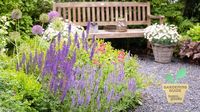As trends in home and garden design evolve, experts are highlighting a significant shift towards natural aesthetics and sustainability for 2025. HGTV star Erin Napier, known for her work on "Home Town," has been vocal about her preference for natural wood designs over painted finishes. In a recent interview, she stated, "The organic movement in wood grain is art!" This perspective aligns with a broader trend where homeowners are increasingly drawn to authentic materials that offer warmth and character.
According to Napier, rather than opting for wood that has been painted over, she encourages the use of natural wood designs that showcase the material's inherent beauty. "Natural wood furnishings create a great base for building a theme or aesthetic," she explained, emphasizing how these pieces can serve as statement items in any room. With the rise of vintage and preowned furniture, homeowners have the opportunity to enhance their spaces without breaking the bank. Sanding and re-staining older pieces can restore their natural tones, allowing for a more personalized touch.
Simultaneously, the gardening world is also embracing a return to simplicity and sustainability. Experts predict that 2025 will see a rise in garden designs that focus on native plants, low-maintenance varieties, and pollinator-friendly environments. Tammy Sons, founder and CEO of TN Nursery, anticipates a trend towards earthy, warm color schemes featuring terracotta, goldenrod, dusty rose, and sage green tones. "During summer 2025, I anticipate a significant trend toward earthy, warm color schemes," said Sons, emphasizing the importance of creating cohesive outdoor spaces that complement the natural environment.
Laura Janney, CEO of the Inspired Garden, echoes this sentiment, suggesting that gentle, muted shades like dusty pinks, lavender, soft peaches, and soft whites will dominate garden palettes. These colors not only evoke tranquility but also align well with traditional and cottage garden styles. Furthermore, the trend connects with Pantone's "Color of the Year," Mocha Mousse, as noted by Katie Rotella, senior PR and digital manager at Ball Horticultural. "This warm, chocolatey brown brings a sense of harmony and indulgence to outdoor spaces," she stated.
In terms of sustainability, Steve Corcoran, CEO of Lawn Love, highlighted the benefits of planting native flowers, which require less maintenance and support local ecosystems. "Sustainability is absolutely going to be a big trend, and planting native flowers will be a staple aspect of that," he explained. Native plants not only thrive in their natural environments but also contribute to the health of local wildlife populations.
Moreover, gardeners are increasingly seeking drought-resistant plants to cope with climate change. Janney noted that homeowners are interested in incorporating plants such as lavender, catmint, and coneflower, which are well-suited for dry conditions. This shift towards practical gardening solutions reflects a growing awareness of environmental issues and a desire for sustainable practices.
Another key trend for 2025 is the focus on creating pollinator-friendly gardens. With many pollinator species facing population declines, gardeners are looking to cultivate spaces that attract and support these vital creatures. Janney remarked, "Butterflies, bees, and birds will continue to be center stage as people demand pollinator-friendly gardens." This approach not only enhances the beauty of gardens but also contributes positively to the environment.
Brett Macdonald, owner of Maverick Landscaping, provided specific recommendations for attracting pollinators. He suggests planting milkweed for monarch butterflies, echinacea and bee balm for bees, and tubular flowers like penstemon and salvias to attract hummingbirds. These choices reflect a growing trend where gardeners are not just focused on aesthetics but also on ecological impact.
Additionally, garden professionals have observed a demand for lower-maintenance and long-blooming varieties. Clients are looking for designs they can enjoy year-round, with plants that require minimal upkeep. Sons noted that "layered, naturalistic planting approaches are gaining popularity because gardeners prefer minimal pruning while allowing plants to grow naturally." This trend emphasizes harmony and functionality over artificial perfection.
As homeowners seek to create vibrant and functional outdoor spaces, they are increasingly drawn to effective ornamental grasses. Macdonald highlighted the appeal of grasses like fountain grass (Pennisetum alopecuroides) and prairie dropseed (Sporobolus heterolepis), which offer texture and movement while requiring little maintenance. These hardy plants can complement other trends and support regenerative gardening goals.
In conclusion, whether it’s through embracing natural wood in home decor or cultivating sustainable gardens, the trends for 2025 reflect a deeper appreciation for authenticity and the environment. As Erin Napier and gardening experts alike advocate for these changes, homeowners are encouraged to explore the beauty of nature in their spaces, fostering a sense of warmth and connection to the world around them.






